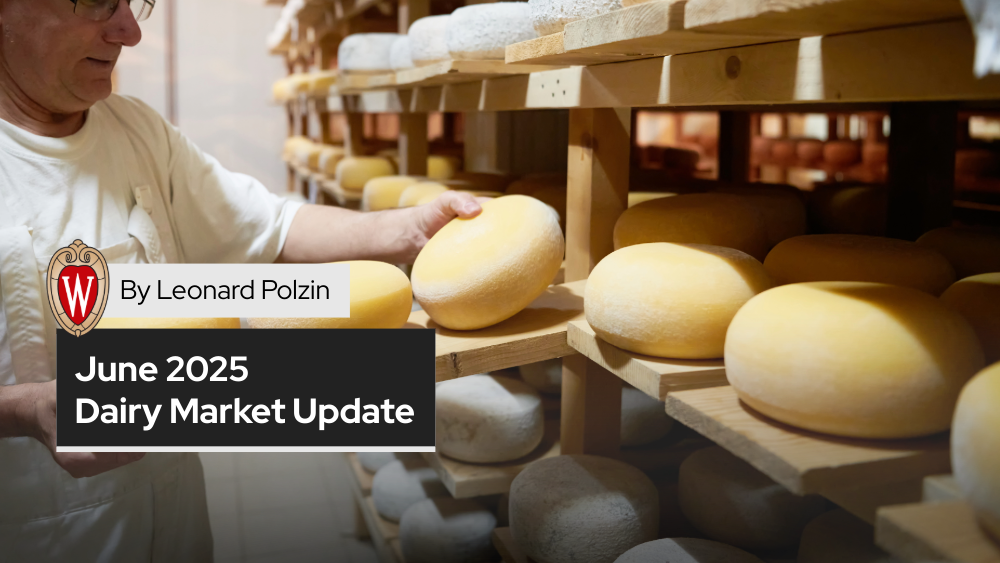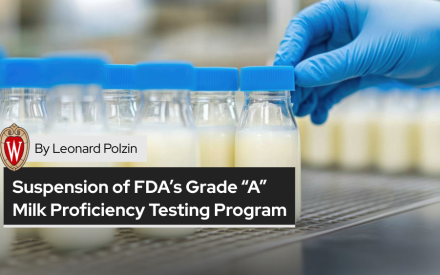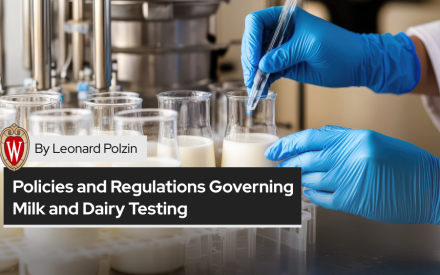
Introduction
This article presents current conditions in the U.S. dairy sector as of June 2025, drawing on insights from market sentiment and recent information. These insights cover domestic demand stagnation, milk supply expansion, processing capacity updates, and global trade dynamics, particularly in relation to cheese, butter, nonfat dry milk, and whey markets. The findings indicate that despite domestic market weakness and increasing milk production, the sector remains buoyed by competitive export positioning, particularly vis-à-vis European counterparts. The analysis also highlights emerging downside risks, including potential export disruptions and structural limits to further growth in international demand. Recent developments in the U.S. dairy industry reflect an interplay between weak domestic fundamentals and supportive global market dynamics.
Domestic Demand Conditions
Domestic demand for dairy products has remained subdued throughout 2025. Sales data from both foodservice and grocery retail segments indicate a plateau, with limited evidence of sustained recovery. Value-oriented consumer behavior persists, with restaurant chain Chili’s cited as a case study in relative foodservice success amid broader stagnation.
Domestic demand for dairy products in the United States remained flat through the first half of 2025. Sales in both the foodservice and grocery retail sectors showed limited growth, with overall consumer spending characterized by value-seeking behavior. Within this environment, Chili’s Grill & Bar reported stronger performance than many other casual dining competitors. Several factors contributed to this outcome.
Chili’s implemented value-based menu promotions, including its “3 for Me” meal offering, which corresponded with a reported 31% increase in comparable sales and a 21–27% increase in customer traffic during early 2025 (Littman, 2025; Canham-Clyne, 2025; Ruggless, 2025). In parallel, the company introduced operational efficiencies through kitchen technology upgrades—such as enhanced display systems and TurboChef ovens—that reduced order preparation times and improved consistency (Littman, 2025). The company also streamlined its menu by removing approximately 25 stock-keeping units, which contributed to operational simplification and focused product delivery (Ruggless, 2025).
Targeted marketing initiatives further supported customer engagement. Digital marketing strategies, particularly through platforms such as TikTok, were designed to reach younger consumer segments, contributing to increased visit frequency and transaction value (Insider Staff, 2025; Business Insider, 2025). Financially, Brinker International, the parent company of Chili’s, reported a 27% increase in overall revenue and a 31% increase in same-store sales for Chili’s during the second quarter of fiscal year 2025 (Investors’ Business Daily, 2025).
By comparison, most U.S. dairy categories experienced continued demand stagnation during this period, with limited support for pricing across both foodservice and retail channels. The high-protein whey segment represented an exception, with modest demand growth and ongoing product innovation. The performance of Chili’s demonstrates that certain foodservice strategies—centered on value, operational efficiency, and targeted marketing—may be effective in maintaining consumer engagement under broader conditions of market constraint.
Industry stakeholders report limited optimism regarding domestic sales performance across most dairy categories. The high-protein whey segment represents a notable exception, continuing to exhibit growth and product innovation. Nevertheless, in aggregate, the domestic demand environment offers limited support to market pricing and provides little insulation from external shocks.
Milk Supply and Production Trends
Contrary to flat demand conditions, U.S. milk production is expanding. The USDA forecasts growth of approximately 0.5% in 2025, supported by modest herd expansion and higher milk per cow. Meanwhile, monthly data indicate year-over-year increases exceeding 1%, with component-adjusted output rising 3.0% in April 2025 due to increased herd size and productivity. This expansion is driven by reduced culling rates and reinvestment in existing facilities (“brownfield” expansion). Dairy processing capacity is concurrently growing: Dairy Gold’s Pasco facility in Washington has commenced milk intake, and multiple processing plants—including those operated by Hilmar and Leprino—are reportedly scaling up, currently operating at around two-thirds of their capacity or higher (Wisconsin Extension, 2025; GreenStone FCS, 2025).
A contrast in processor sentiment has emerged. Firms with primarily domestic market exposure report weaker performance and subdued optimism. In contrast, exporters benefit from stronger external demand and constrained global milk supply, which supports their outlook (Brownfield Ag News, 2025; Wisconsin Extension, 2025).
Global Market Position and Export Dynamics
Export competitiveness continues to be a critical driver of U.S. dairy market stability. U.S. dairy commodities remain priced at a discount relative to global counterparts, facilitating sustained export volumes. As of early June, European butter prices exceed $3.60/lb, while European cheese prices remain above $2.20/lb. This differential enables U.S. products to capture global market share, even amidst rising domestic production. European dairy production has been constrained by multiple factors, including stagnant herd growth, disease concerns (e.g., Bluetongue), and regulatory barriers to large-scale farm development. Despite an extended period of profitability, European milk output has not responded in proportion to price signals. This creates an export window for U.S. producers but also introduces fragility—any reversal in European supply conditions will likely adversely affect U.S. export volumes and pricing power.
At the same time, U.S. wholesale dairy prices remain considerably lower than their European counterparts. As of early June 2025, wholesale butter in the U.S. traded between $2.46 and $2.57 per pound, based on USDA weekly averages and CME spot market data. Similarly, block cheddar cheese prices hovered around $1.80 to $1.93 per pound. These price levels are well below the European benchmarks, reinforcing the relative price advantage of U.S. dairy products in global markets. Retail prices in the U.S. remain higher due to processing and distribution markups—averaging $4.38/lb for butter and approximately $2.60 to $2.74 for natural cheese products in consumer markets—but these retail figures are less relevant for export competitiveness than the underlying commodity valuations.
This price gap between U.S. and European dairy products has enabled U.S. exporters to maintain and even expand market share in key overseas destinations. However, this advantage is contingent on continued cost competitiveness, exchange rate dynamics, and stable domestic supply conditions. Should European production begin to recover—whether through improved animal health, regulatory flexibility, or policy intervention—the current export pricing advantage could narrow quickly. Moreover, if U.S. milk production continues to expand without corresponding demand growth, the risk of domestic oversupply and downward price pressure increases.
Thus, while current price differentials support U.S. dairy exports, the durability of this window is uncertain and subject to both international and domestic market developments.
Commodity Market Assessment
Commodity-specific developments vary across the dairy complex:
Cheese
U.S. cheese exports require a sustained price discount (approximately $0.20/lb) to remain competitive. This pricing dynamic establishes a ceiling for domestic cheese prices. Market risk remains elevated due to the possibility of abrupt export order cancellations, which could trigger sharp price corrections in the range of +$0.10–0.15/lb.
Butter
U.S. butter remains competitively priced in global markets, particularly relative to European benchmarks. As of early June 2025, wholesale butter prices in the U.S. ranged from $2.46 to $2.57 per pound, supported by steady commercial demand and export interest (USDA AMS, 2025a). While these levels remain below European butter prices—which continue to trade above $3.60/lb—they also lack the clear pricing ceiling observed in other commodities such as cheese. Industry observers have noted that should European butter prices decline to approximately $2.60 per pound, U.S. butter values could follow suit, potentially softening into the low $2.30’s. Such a decline would not signal structural weakness but rather a market-based adjustment within normal trading ranges (Endlich, 2025; USDA AMS, 2025a). The USDA’s long-range forecast continues to reflect average butter prices around $2.79/lb for 2025, supporting the likelihood of fluctuation within this corridor without indicating a collapse (USDA WASDE, 2024).
Nonfat Dry Milk (NFDM)
The NFDM market in the United States has shown resilience in 2025, recovering from earlier periods of deep discounting. Much of the rebound can be attributed to a resurgence in demand from Mexico, which remains a primary importer of U.S. NFDM, coupled with tighter inventories in domestic production regions (USDA AMS, 2025b). Current NFDM prices have reached levels generally considered near a short-term ceiling, averaging just above $1.20/lb in early June. Analysts suggest that any weakening in export demand or inventory adjustment could lead to a price reduction of approximately $0.10/lb, which, under prevailing Federal Milk Marketing Order (FMMO) formulas, would equate to a roughly $1.00 per hundredweight (cwt) decline in the Class IV milk price (USDA AMS, 2025c). This dynamic underscores the sensitivity of NFDM values to small shifts in demand or production, especially within the context of international market exposure.
Dry Whey
Dry whey markets have demonstrated sustained strength, primarily due to high-protein derivative demand and constrained spot availability. Demand for derivative products such as whey protein concentrates and isolates has kept upward pressure on dry whey prices, despite added capacity from new processing facilities such as those operated by Leprino Foods (Dairy Processing, 2024). Wholesale prices for dry whey have approached $0.48/lb in recent weeks (The Bullvine, 2025), a level supported more by downstream functional protein demand than traditional food uses. Nonetheless, market analysts are increasingly cautious about downside risk. A price correction in the range of $0.10 to $0.15/lb is considered possible, and such a move would likely reduce the Class III milk price by up to $0.60/cwt, given the weighting of whey solids in the federal milk pricing formula (USDA AMS, 2025c). No measurable decline has yet materialized, suggesting ongoing support in the near term.
Price Risk Management and Strategic Outlook
Producers and processors should remain vigilant in light of market volatility. While the near-term environment allows for modest price strength, the longer-term outlook depends heavily on sustained international demand and limited global supply growth. Risk management strategies might want to differentiate between nearby and deferred pricing opportunities.
Conclusion
As of June 2025, the U.S. dairy sector remains in a precarious balance. Domestic demand offers little support, while international dynamics temporarily compensate for rising supply and expanded processing capacity. Export competitiveness remains the central buffer on prices. The fragility of this position—particularly in light of global supply uncertainties—necessitates close monitoring and planning.
References
- Brownfield Ag News. (2025, May 12). Dairy supply expected to rise. https://www.brownfieldagnews.com/news/dairy-supply-expected-to-rise
- Business Insider. (2025, February 21). How ‘cheeky’ Chili’s has hit it off with younger customers. https://www.businessinsider.com
- Canham-Clyne, A. (2025, April 29). Chili’s notches 21% traffic surge. Restaurant Dive. https://www.restaurantdive.com
- Ferrier, P. (2025, February 27). Dairy outlook [PDF]. U.S. Department of Agriculture, Economic Research Service. https://iowaagribusinessradionetwork.com/usda-forecasts-for-milk-production-and-price-projections-in-2025/#:~:text=USDA%E2%80%99s%20Agricultural%20Outlook%20Forum%20helps%20to%20provide%20milk,Peyton%20Ferrier%20predicted%20an%20overall%20milk%20production%20increase
- GreenStone Farm Credit Services. (2025). U.S. dairy market maintains upward momentum. https://www.greenstonefcs.com
- Insider Staff. (2025, February 21). Dallas-based Chili’s is attracting younger diners. Axios. https://www.axios.com
- Investors’ Business Daily. (2025, May 9). Brinker International stock hits all-time high. https://www.investors.com
- Littman, J. (2025, January 30). How Chili’s boosted comparable sales by 31%. Restaurant Dive. https://www.restaurantdive.com
- Ruggless, R. (2025, May 27). Chili’s turnaround leads to sales growth. Nation’s Restaurant News. https://www.nrn.com
- The Bullvine. (2025, May 21). The great dairy migration: April’s production surge reveals who’s winning and losing. https://www.thebullvine.com
- University of Wisconsin–Madison Extension. (2025, February). February 2025 dairy market update: U.S. dairy industry overview. https://farms.extension.wisc.edu/articles/february-2025-dairy-market-update-us-dairy-industry-overview/
- Dairy Processing. (2024, September). Erratic demand: Dairy prices expected to rise. https://www.dairyprocessing.com
- Endlich, J. (2025, June 6). Butter breaks $2.50/lb as US celebrates national dairy month amid mixed production signals. Vesper. https://www.vespergroup.net/news
- The Bullvine. (2025, March 20). CME dairy market report: Class III futures surge above USDA forecast. https://www.thebullvine.com
- U.S. Department of Agriculture, Agricultural Marketing Service. (2025a, June 13). Dairy Market News Weekly Report – Volume 92, Report 24. https://www.ams.usda.gov
- U.S. Department of Agriculture, Agricultural Marketing Service. (2025b, June 13). Nonfat Dry Milk – Central and West Summary. https://www.ams.usda.gov
- U.S. Department of Agriculture, Agricultural Marketing Service. (2025c, June 4). Announcement of Class and Component Prices for May 2025. https://www.ams.usda.gov
- U.S. Department of Agriculture, World Agricultural Outlook Board. (2024, October). World Agricultural Supply and Demand Estimates (WASDE). https://www.usda.gov/oce/commodity/wasde


 Milk, Cookies, and Christmas Eve: Santa’s Dairy Tab by the Numbers
Milk, Cookies, and Christmas Eve: Santa’s Dairy Tab by the Numbers U.S.–Canada Dairy Trade Relationship (2025–Present)
U.S.–Canada Dairy Trade Relationship (2025–Present) Suspension of FDA’s Grade “A” Milk Proficiency Testing Program – A Comprehensive Analysis
Suspension of FDA’s Grade “A” Milk Proficiency Testing Program – A Comprehensive Analysis Policies and Regulations Governing Milk and Dairy Testing: A Wisconsin Overview
Policies and Regulations Governing Milk and Dairy Testing: A Wisconsin Overview


